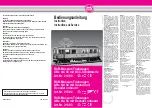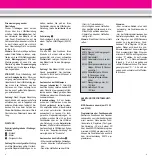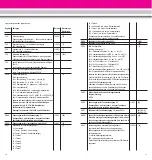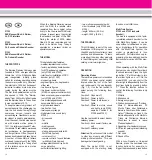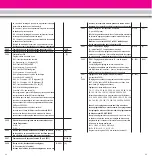
“2” on the Loco Remote or Universal
Remote.
When using the MTS components
marked with a “p,” this railcar can
receive "parallel" function com-
mands, which eliminate the pause
that occurs when a "serial" command
is received.
Parallel: Command is send directly.
Serial: Command is send as a string
of "1" commands, for example, 3 = 1
+ 1 + 1).
Most MTS components can be
upgraded to parallel function com-
mands (Exceptions: first generation
55000 MTS Central Station, 55010
Train Mouse). For more information,
contact your authorized retailer or go
to www.lgb.com.
When operating with the Multi-Train
System, the railcar features a “Back-
EMF” function. This keeps the motor
speed constant (and under normal
conditions the railcar speed), even
when the load of the railcar changes,
for example, in curves or on grades.
This feature does not work at top
speed, because additional voltage
must be available to overcome any
added load.
If desired, numerous functions of the
onboard decoder, such as accelera-
tion, braking, direction of travel and
many others, can be programmed
using a PC and the 55045 MTS PC
Decoder Programming Module (see
Instructions for advanced users).
These functions also can be pro-
grammed with the 55015 Universal
Remote.
21390 (analog version):
The model is equipped with a digital
interface to connect a 3 amp DCC
decoder (Fig. 6). Remove the plug on
the decoder interface and connect
the decoder.
For use with the LGB Multi-Train
System, we recommend the models
21392 and 21393, which already are
equipped with onboard decoders.
Sound (only 21392)
This model features a digital elec-
tronic sound system. The volume
control is located in the front cab
underneath the pantograph (Fig. 3).
Turn the volume control clockwise to
increase the volume.
Sounds after turning on the throttle:
When the throttle is turned to a low
setting, you first hear the compres-
sor for five seconds. Then the fan
runs in the lowest setting.
When the throttle is turned up, you
hear the drive sounds and the sec-
ond, faster setting of the fan. The
drive sounds are proportional to the
speed of the railcar.
When operating with the Multi-Train
System, you can set the sound so
that it is load-dependent: Like on a
prototype railcar, the drive sounds
are less pronounced when going
downhill or braking. To activate this
option, program Bit4 in CV54 to "8"
(see Instructions for Advanced
Users).
All sound features described below
also can be controlled directly with
the LGB Multi-Train System (see
Multi-Train System).
Whistle: The whistle sounds auto-
matically when the railcar is started.
The whistle also can be triggered by
the LGB Sound Magnet (17050)
included with this model. The 17050
snaps between the ties of most LGB
track sections.
The magnet in the 17050 is under the
LGB logo. If the contact is installed
with the logo on the right side of the
track (in the direction of travel), it will
trigger the whistle as the model
passes.
Brake: To trigger the “squealing”
brake sound, reduce the model’s
speed slowly. This requires a skilled
hand and a little practice.
Standing sounds: With the Multi-
Train System, you hear the fan in its
lowest setting while the railcar is
standing.
To hear the standing sounds with an-
alog operation, a low voltage (approx.
6.5 volts) must be maintained on the
tracks. Turn the throttle to a low set-
ting so that the railcar does not yet
start, but you can hear the sounds.
Hint: To obtain standing sounds with
analog operation while the throttle is
turned off and when reversing the
railcar's direction, the 65011 Sound
Unit Power Storage must be
installed. For questions regarding the
installation of the 65011, please con-
tact your authorized retailer.
Adding sound to 21390 and 21393:
To equip these models with sound,
we recommend the following prod-
ucts:
- 65004 European Electric Loco
Sound Unit
- 65011 Sound Unit Power Storage
On the main circuit board of the rail-
car, there are two pins between the
two motor plugs. These pins can be
used to connect the 65004 Sound
Unit. The 65011 is not needed when
operating with the LGB Multi-Train
System.
If there is not enough space inside
the railcar or if you prefer not to dis-
assemble the model, you can place
the Sound Unit in a freight or pas-
senger car and connect it to the rail-
car via the multi-purpose socket
(only 21393).
Lighting
This model features directional light-
ing: Three white front lights and one
white rear light. Transparent red
stickers are included with the model
to obtain a prototypical red rear light
when running without a train.
The model has a "flat" multi-purpose
socket, with a removable cover, on
each end wall (only 21392 and
21393, Fig. 4). These sockets can be
used to provide track power to LGB
cars with lighting or sound electron-
ics.
To remove the cover of a socket, pull
it straight out. If the cover is tight,
gently use a small straight screw-
driver to pry it out. (Do not pull out
the rectangular outer housing.)
Power Supply
Attention! For safety and reliability,
operate this model with LGB power
supplies (transformers, power packs
and controls) only. The use of non-
LGB power supplies will void your
warranty.
Use this model with LGB power sup-
plies with an output of more than 1
amp. For more information on LGB
power supplies for indoor, outdoor
and multi-train operation, see the
LGB catalog.
Catenary Power Operation
This railcar can be operated with a
powered catenary system (see Oper-
ating Modes). The bottom of this
model is marked with a red dot.
Place the model on the track with the
red dot pointing to the rail that is not
connected to the catenary power
supply (Fig. 5).
Hint: To operate multiple trains on
the same track, we recommend the
LGB Multi-Train System (see Multi-
Train System). With the Multi-Train
System, you can use an unpowered
catenary system for prototypical
appearance.
17
16

